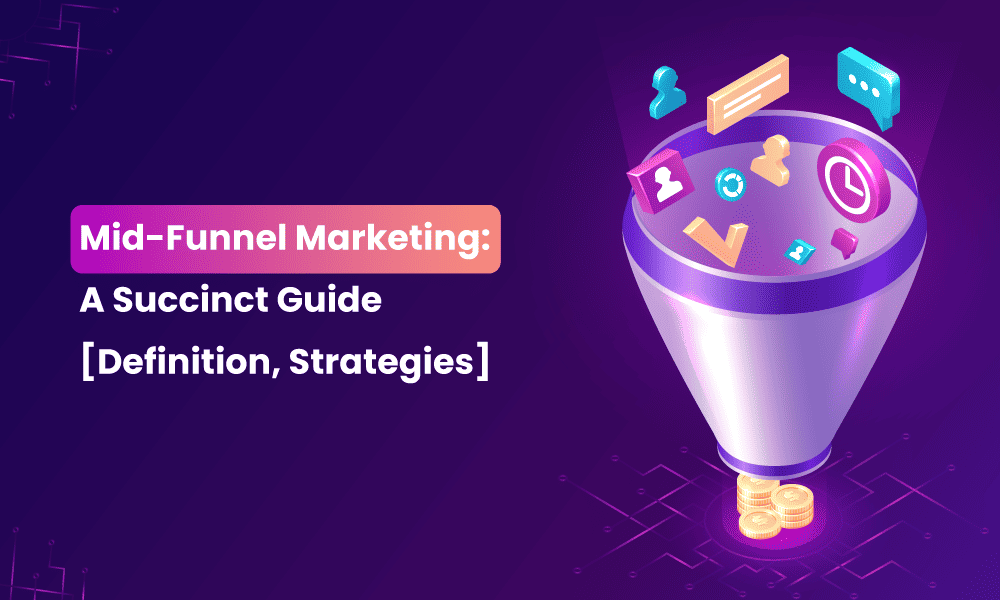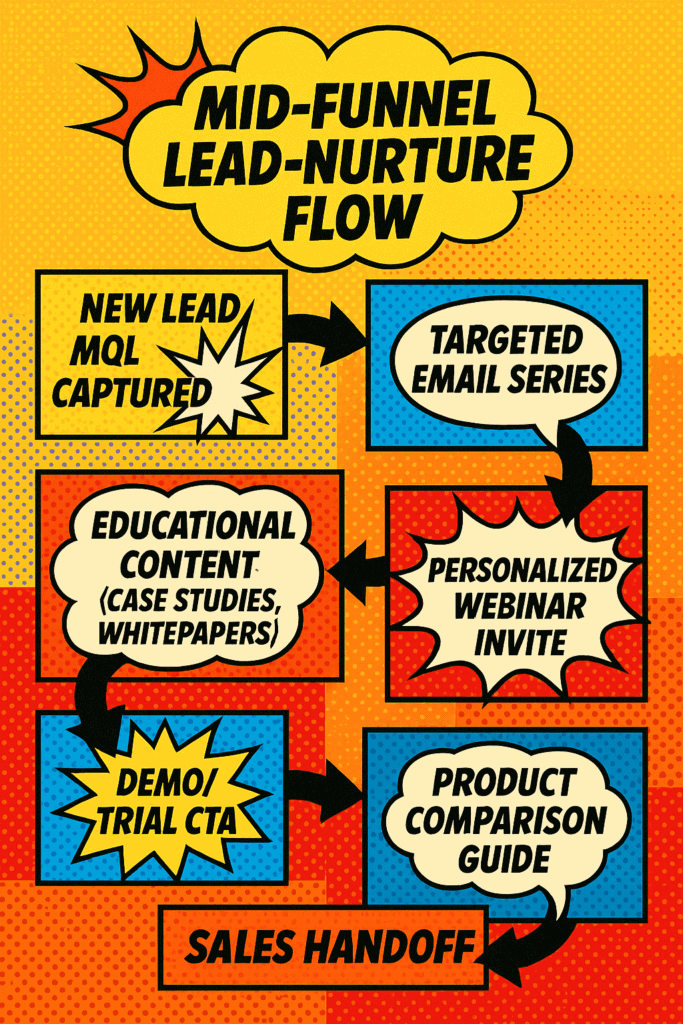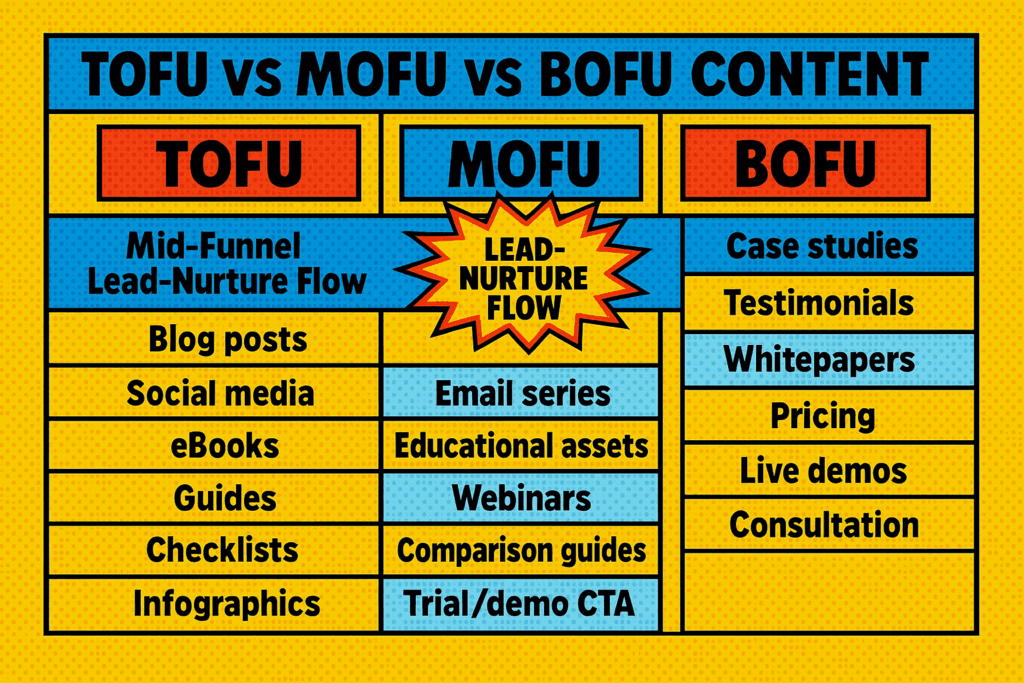Mid-funnel marketing isn’t just a nice-to-have—it’s a measurable revenue driver.
Mailchimp’s 2024 Holiday Season Trends report found that e-commerce brands running automated, mid-funnel email flows (welcome, browse-abandon, product-recommendation) generated 20 % more revenue year-over-year in the four weeks leading up to Giving Tuesday—without increasing send volume. Source: mailchimp.com
So, what exactly is the middle-of-funnel (MoFu) marketing? What are the strategies and tips to help businesses target this tier of leads?
Check out Gartner’s definition of a funnel here.
We’ll explore the answers to these in this blog.
Let’s get started!
Table of Contents
What Is Mid-Funnel Marketing?
Mid-funnel marketing, also referred to as middle-of-the-funnel marketing, is catering to a different class of leads, as we discussed in the intro.
These leads are past the awareness stage by now. They have interest and are currently evaluating what your small business has to offer.
They’re aware of their problems and pain points and are considering which products or services could be a potential fit.
However, they have yet to reach the bottom of the funnel, which is usually when purchasing decisions get made.
New leads can enter your small business sales funnel from the middle, especially if they’re qualified leads.
Your new customers can even arrive during their second pass-through on the sales funnel in this part. Your goal is different than when working with leads, in that you’re trying to encourage a repeat purchase.
With new leads, even if they are qualified leads, you’re trying to get them to make a first-time purchase.
However, now is not the time to begin bombarding your leads with sales messages trying to cinch that deal.
They are still in the evaluation stage, after all, and they will stay there until they make up their mind.
Rather than trying to earn the sale prematurely, your primary goal with mid-funnel marketing is to nurture these leads or new customers.
Here’s a recent Outbrain study on MOFU performance
You want to provide information that will educate them on your products and services.
Even if they enter the funnel already cognizant of what your small business offers, that doesn’t mean the lead knows everything yet.
After all, if they did, they would have already made their purchasing decision or exited from the funnel when they decided that your products and services aren’t good enough for them.
Read also: 5 Essential Marketing Funnel Basics Every Business Needs to Know
Enhance Your Email Marketing
Want to make your emails more impactful? Check out our beautiful, easy-to-customize recruitment and marketing email templates. Designed to boost engagement, these templates from EngageBay will help your emails stand out. Just customize the images, headings, and CTAs for your brand, and hit send in a few minutes!
Middle-of-the-Funnel Marketing Strategies & Content Ideas
Keeping in mind your goals when working with leads at this stage of the sales funnel, we now want to share the following mid-funnel marketing strategies that you can utilize.
These tactics should guide your lead further down the funnel.
Product or service pages
A product or service page is like a landing page but less salesy.
You’re just trying to educate your lead about your products and services as much as you can.
You will have to write a page for every product or service in your roster, which cannot be helped.
If you have resources or guides on your product or service, include hyperlinks to this helpful information.
You can also add links to past blog posts and videos on a product or service, especially if it’s been around for a while.
Avoid the need to talk about pricing or reviews or anything of that sort.
Your lead is probably aware of all this information already anyway, and that veers too far from the kind of info you’re supposed to provide to leads in this stage of the sales funnel.
👉 Elevate your email marketing with our free email templates designed to boost engagement and conversions.
Read also: A Beginner’s Guide to Lead Funnels: How to Double Your Sales
Webinars
A webinar is another valuable opportunity to teach your mid-funnel leads about your products or services.
Since your lead isn’t yet ready to make a purchasing decision, we doubt they’d pay for a webinar at this stage either.
You thus might decide to offer the webinar for free only to mid-funnel leads and then charge existing customers to access the same webinar.
If the webinar is older and can be repurposed, then you won’t be so concerned with charging for it since you probably already made good money from that webinar anyway.
Outside of the webinar itself, you can also offer transcripts at this time for the busy lead who might not have time to watch your entire webinar.
Read also: eCommerce Conversion Funnel in 5 Stages
Email newsletters
Since your lead is interested and informed, the chances are good that they’ve already opted into your email list.
If you’re not already producing automated email content to go to your middle-of-the-funnel leads compared to your bottom-of-the-funnel and top-of-the-funnel leads, you need to.
Email newsletters are a great example of such content.
You might only send newsletters periodically, such as once a month or once a quarter, but each time you send a newsletter, it pushes your brand to the top of the lead’s mind.
Of course, you don’t want to wait an entire quarter for the lead to make their purchasing decision, so that’s why you’ll supplement email newsletters with other forms of content.
Read also: How to Maximize ROI With Strategic Product Placement
Case studies
For instance, case studies are a great mid-funnel marketing tactic. Case studies generate trust and authority in your small business and prove that your products and services can fulfill the needs of others.
If your lead sees their own problem or a problem like theirs being solved by your products and services, that can push them to make a purchasing decision.
👉 Boost your email marketing campaigns with EngageBay’s customizable email templates tailored for engagement and success.
Read also: What Is Direct Marketing? Does It Work? [13 Ways To Do It]
Blog posts
Blog content is also very useful mid-funnel content.
Rather than take existing blog posts and send them to your lead, create content specifically for middle-of-the-funnel leads.
What kinds of questions do they have at this stage that need answering?
What do they need to know about your products and services that they don’t already? What do they need to know about your company that they don’t already?
Keeping these questions in mind, create an editorial calendar where you produce mid-funnel content.
Read also: Marketing Automation Funnel Explained For Beginners
Mid-Funnel KPIs You Must Track
A healthy mid-funnel keeps sales calendars full and Customer Acquisition Cost in check. Below are the four numbers every SaaS marketer should have on their dashboard, plus realistic 2025 benchmarks and quick optimization tips.
1. CTR on Gated Assets
What it tells you: How compelling your in-content CTAs are at persuading visitors to click through to a white-paper, ROI calculator, or other gated offer.
Good benchmark: 2 – 5 % click-through from the surrounding channel (blog, newsletter, social ad) to the asset’s landing page. High performers push 6 %+. Source: datadab.com
Quick win: Test micro-copy around the button (“Get the template →” instead of “Submit”) and surface social proof (e.g., “Trusted by 3,100 RevOps teams”) right under the CTA to lift CTR by 15-20 %.
2. Email-Nurture Open Rate
What it tells you: Relevance of your subject line and list hygiene once leads have opted in.
Good benchmark: 15 – 25 % for B2B SaaS nurture sequences; >30 % puts you in the top quartile. Source: callin.io
Pro move: Use intent tags from product usage (e.g., last feature touched) in the subject line—campaigns that did this saw 10-15 % higher opens in Callin’s 2025 dataset. Pair with A/B tests on send-time to eke out a few extra points.
3. Demo-Request Conversion
What it tells you: How many “hand-raisers” turn into booked meetings after filling out a demo form.
Good benchmark: Industry average is ~30 % of qualified form fills that lock a calendar slot; adding instant self-scheduling bumps that to 66.7 %. Source: chilipiper.com
Speed hack: Embed a calendar or live-call option on the confirmation screen. Chili Piper’s analysis of 4 M submissions shows form-scheduling doubles the conversion rate—no extra traffic required.
4. MQL ▶ SQL Ratio
What it tells you: Alignment between your lead-scoring model and sales acceptance criteria.
Good benchmark: 10 – 15 % for “average” SaaS orgs; revenue engines firing on all cylinders hit 20-25 %. Source: callin.io
Fix mis-fires fast: Review deals lost at the very first sales call. Common pattern—marketing counts content downloaders from <50-person companies as MQLs while sales only wants ≥200-person accounts. Tighten firmographic filters or adjust scoring weights and watch the ratio climb.
Why these four? Together they form a chain: CTR drives asset traffic → nurture opens warm those leads → demo requests create real pipeline → MQL-to-SQL tells you if pipeline quality matches quantity. Track them weekly, set stretch targets 20 % above your current baseline, and iterate in that order—each step amplifies the next.
Conclusion
Mid-funnel marketing required different types of content altogether. The leads that enter the sales funnel here are more informed than most leads but are still on the fence about their purchasing decisions.
By using the marketing strategies we outlined here today, you can inform and guide mid-funnel leads on their way to the bottom of the funnel.
Frequently Asked Questions
1. What is mid-funnel marketing?
Mid-funnel marketing (often called MOFU) is the stage where prospects have shown initial interest and are now evaluating whether your SaaS solution solves their problem. Strategies like lead nurturing emails, webinars, case-study downloads, and comparison guides build trust and move leads closer to purchase, making mid-funnel marketing essential for improving conversion rates.
2. How is MOFU different from TOFU and BOFU?
TOFU (top-of-funnel) focuses on broad awareness, MOFU (mid-funnel marketing) centers on education and qualification, and BOFU (bottom-of-funnel) drives the final purchase decision. MOFU bridges the gap by turning engaged leads into sales-ready opportunities through targeted content such as product demos, ROI calculators, and nurture sequences.
3. Which content formats work best for mid-funnel marketing?
High-performing MOFU content includes in-depth case studies, gated ebooks, live demos, and comparison sheets—assets that answer technical questions and showcase social proof. Interactive tools like ROI calculators and self-guided product tours also excel in mid-funnel marketing because they let prospects visualize real value before talking to sales.
4. What KPIs should I track in mid-funnel marketing?
Key MOFU metrics include click-through rate (CTR) on gated assets, email-nurture open rates, demo-request conversions, and the MQL-to-SQL ratio. Monitoring these KPIs tells you how effectively your mid-funnel marketing is transforming engaged leads into qualified pipeline.
5. How do you build a successful mid-funnel marketing strategy for SaaS?
Start by mapping buyer questions to specific mid-funnel assets (e.g., comparison guides for pricing concerns). Segment leads by intent signals, automate tailored email sequences, and enrich data to refine lead scoring. Consistently test CTAs, personalization, and timing—continuous optimization drives stronger mid-funnel marketing performance and lowers Customer Acquisition Cost (CAC).
👉 Have you tried our email templates? Share your experience in the comments below, and let us know how they worked for your campaigns!



